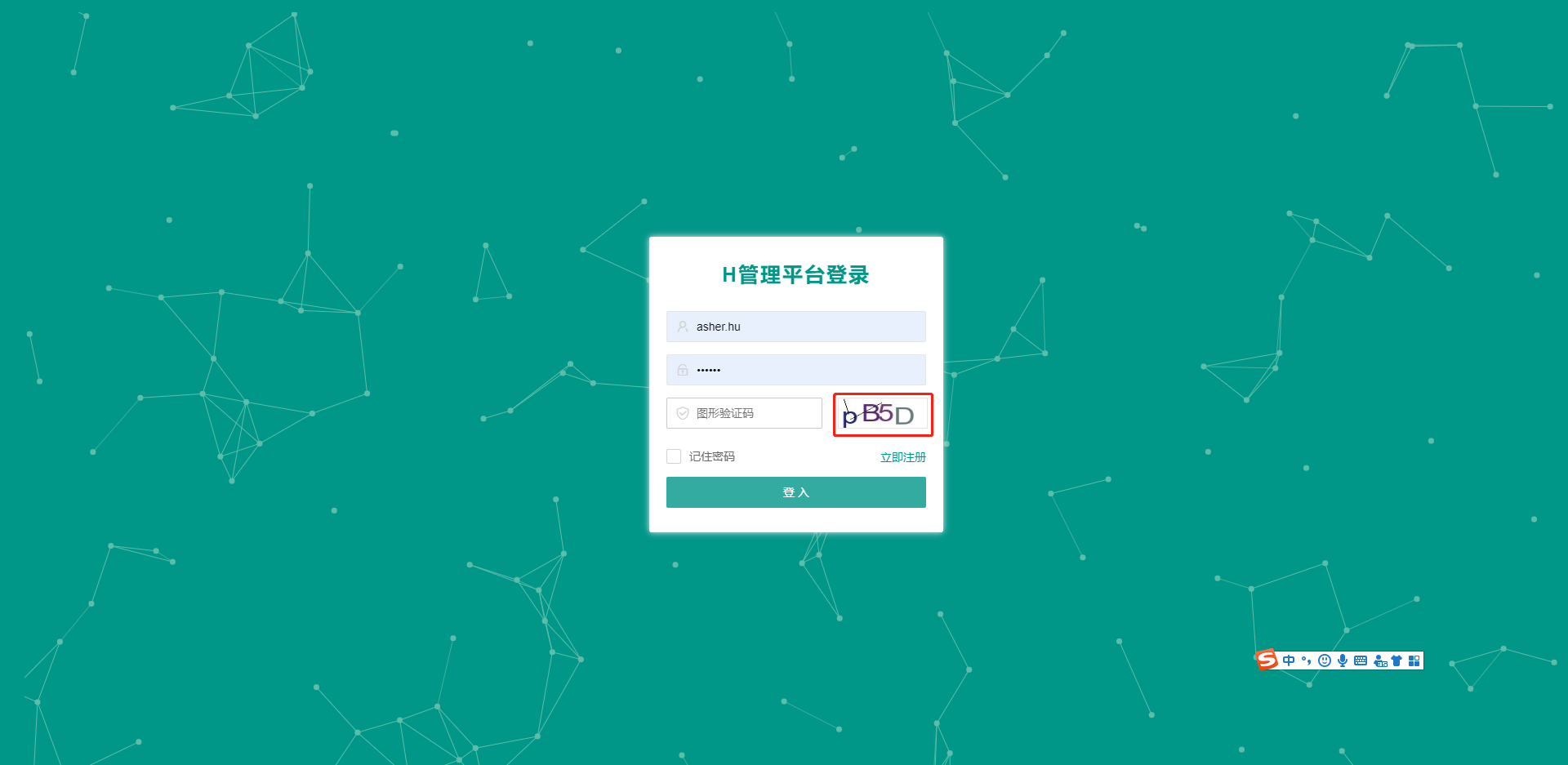flask实现验证码并验证
效果图:
点击图片、刷新页面、输入错误点击登录时都刷新验证码

实现步骤:
第一步:先定义获取验证码的接口
verificationCode.py
1 #验证码
2 @api.route('/imgCode')
3 def imgCode():
4 return imageCode().getImgCode()
此处的@api是在app下注册的蓝图,专门用来做后台接口,所以注册了api蓝图

第二步:实现接口逻辑
1)首先实现验证码肯定要随机生成,所以我们需要用到random库,本次需要随机生成字母和数字,
所以我们还需要用到string。string的ascii_letters是生成所有字母 digits是生成所有数字0-9。具体代码如下
1 def geneText():
2 '''生成4位验证码'''
3 return ''.join(random.sample(string.ascii_letters + string.digits, 4)) #ascii_letters是生成所有字母 digits是生成所有数字0-9
2)为了美观,我们需要给每个随机字符设置不同的颜色。我们这里用一个随机数来给字符设置颜色
1 def rndColor():
2 '''随机颜色'''
3 return (random.randint(32, 127), random.randint(32, 127), random.randint(32, 127))
3)此时我们已经可以生产图片验证码了,利用上面的随机数字和随机颜色生成一个验证码图片。
这里我们需要用到PIL库,此时注意,python3安装这个库的时候不是pip install PIL 而是pip install pillow。
1 def getVerifyCode():
2 '''生成验证码图形'''
3 code = geneText()
4 # 图片大小120×50
5 width, height = 120, 50
6 # 新图片对象
7 im = Image.new('RGB', (width, height), 'white')
8 # 字体
9 font = ImageFont.truetype('app/static/arial.ttf', 40)
10 # draw对象
11 draw = ImageDraw.Draw(im)
12 # 绘制字符串
13 for item in range(4):
14 draw.text((5 + random.randint(-3, 3) + 23 * item, 5 + random.randint(-3, 3)),
15 text=code[item], fill=rndColor(), font=font)
16 return im, code
4)此时,验证码图片已经生成。然后需要做的就是把图片发送到前端去展示。
1 def getImgCode():
2 image, code = getVerifyCode()
3 # 图片以二进制形式写入
4 buf = BytesIO()
5 image.save(buf, 'jpeg')
6 buf_str = buf.getvalue()
7 # 把buf_str作为response返回前端,并设置首部字段
8 response = make_response(buf_str)
9 response.headers['Content-Type'] = 'image/gif'
10 # 将验证码字符串储存在session中
11 session['imageCode'] = code
12 return response
这里我们采用讲图片转换成二进制的形式,讲图片传送到前端,并且在这个返回值的头部,需要标明这是一个图片。
将验证码字符串储存在session中,是为了一会在登录的时候,进行验证码验证。
5)OK,此时我们的接口逻辑已经基本完成。然后我们还可以给图片增加以下干扰元素,比如增加一点横线。
1 def drawLines(draw, num, width, height):
2 '''划线'''
3 for num in range(num):
4 x1 = random.randint(0, width / 2)
5 y1 = random.randint(0, height / 2)
6 x2 = random.randint(0, width)
7 y2 = random.randint(height / 2, height)
8 draw.line(((x1, y1), (x2, y2)), fill='black', width=1)
然后getVerifyCode函数需要新增一步
1 def getVerifyCode():
2 '''生成验证码图形'''
3 code = geneText()
4 # 图片大小120×50
5 width, height = 120, 50
6 # 新图片对象
7 im = Image.new('RGB', (width, height), 'white')
8 # 字体
9 font = ImageFont.truetype('app/static/arial.ttf', 40)
10 # draw对象
11 draw = ImageDraw.Draw(im)
12 # 绘制字符串
13 for item in range(4):
14 draw.text((5 + random.randint(-3, 3) + 23 * item, 5 + random.randint(-3, 3)),
15 text=code[item], fill=rndColor(), font=font)
16 # 划线
17 drawLines(draw, 2, width, height)
18 return im, code
最终接口逻辑完成。整体接口代码如下
1 from .. import *
2 from io import BytesIO
3 import random
4 import string
5 from PIL import Image, ImageFont, ImageDraw, ImageFilter
6
7 #验证码
8 @api.route('/imgCode')
9 def imgCode():
10 return imageCode().getImgCode()
11
12
13 class imageCode():
14 '''
15 验证码处理
16 '''
17 def rndColor(self):
18 '''随机颜色'''
19 return (random.randint(32, 127), random.randint(32, 127), random.randint(32, 127))
20
21 def geneText(self):
22 '''生成4位验证码'''
23 return ''.join(random.sample(string.ascii_letters + string.digits, 4)) #ascii_letters是生成所有字母 digits是生成所有数字0-9
24
25 def drawLines(self, draw, num, width, height):
26 '''划线'''
27 for num in range(num):
28 x1 = random.randint(0, width / 2)
29 y1 = random.randint(0, height / 2)
30 x2 = random.randint(0, width)
31 y2 = random.randint(height / 2, height)
32 draw.line(((x1, y1), (x2, y2)), fill='black', width=1)
33
34 def getVerifyCode(self):
35 '''生成验证码图形'''
36 code = self.geneText()
37 # 图片大小120×50
38 width, height = 120, 50
39 # 新图片对象
40 im = Image.new('RGB', (width, height), 'white')
41 # 字体
42 font = ImageFont.truetype('app/static/arial.ttf', 40)
43 # draw对象
44 draw = ImageDraw.Draw(im)
45 # 绘制字符串
46 for item in range(4):
47 draw.text((5 + random.randint(-3, 3) + 23 * item, 5 + random.randint(-3, 3)),
48 text=code[item], fill=self.rndColor(), font=font)
49 # 划线
50 self.drawLines(draw, 2, width, height)
51 return im, code
52
53 def getImgCode(self):
54 image, code = self.getVerifyCode()
55 # 图片以二进制形式写入
56 buf = BytesIO()
57 image.save(buf, 'jpeg')
58 buf_str = buf.getvalue()
59 # 把buf_str作为response返回前端,并设置首部字段
60 response = make_response(buf_str)
61 response.headers['Content-Type'] = 'image/gif'
62 # 将验证码字符串储存在session中
63 session['imageCode'] = code
64 return response
第三步:前端展示。
这里前端我使用的是layui框架。其他框架类似。
1 <div class="layui-form-item">
2 <label class="layui-icon layui-icon-vercode" for="captcha"></label>
3 <input type="text" name="captcha" lay-verify="required|captcha" placeholder="图形验证码" autocomplete="off"
4 class="layui-input verification captcha" value="">
5 <div class="captcha-img">
6 <img id="verify_code" class="verify_code" src="/api/imgCode" onclick="this.src='/api/imgCode?'+ Math.random()">
7 </div>
8 </div>
js:主要是针对验证失败以后,刷新图片验证码
1 // 进行登录操作 2 form.on('submit(login)', function (data) { 3 console.log(data.elem); 4 var form_data = data.field; 5 //加密成md5 6 form_data.password=$.md5(form_data.password); 7 $.ajax({ 8 url: "{{ url_for('api.api_login') }}", 9 data: form_data, 10 dataType: 'json', 11 type: 'post', 12 success: function (data) { 13 if (data['code'] == 0) { 14 location.href = "{{ url_for('home.homes') }}"; 15 } else { 16 //登录失败则刷新图片验证码 17 var tagImg = document.getElementById('verify_code'); 18 tagImg.src='/api/imgCode?'+ Math.random(); 19 console.log(data['msg']); 20 layer.msg(data['msg']); 21 } 22 } 23 }); 24 return false; 25 });
第四步:验证码验证
验证码验证需要在点击登录按钮以后,在对验证码进行效验
1)首先我们获取到前端传过来的验证码。.lower()是为了忽略大小写
这里的具体写法为什么这样写可以获取到前端传过来的参数,可以自行了解flask框架
1 if request.method == 'POST':
2 username = request.form.get('username')
3 password = request.form.get('password')
4 captcha = request.form.get('captcha').lower()
2)对验证码进行验证.因为我们在生成验证码的时候,就已经把验证码保存到session中,这里直接取当时生成的验证码,然后跟前端传过来的值对比即可。
1 if captcha==session['imageCode'].lower():
2 pass
3 else:
4 return jsonify({'code':-1,'msg':'图片验证码错误'})
到此,已完成了获取验证码、显示验证码、验证验证码的所有流程。验证验证码中没有把整体代码写出来。可以根据自己情况自己写。
注:转载请注明出处。谢谢合作~




